Best Cod Liver Oil Brands (2023)
Looking for the best cod liver oil? Not all cod liver oil brands are the same. I researched 10 different brands and found only one that stands head and shoulders above the rest as the best cod liver oil on the market.
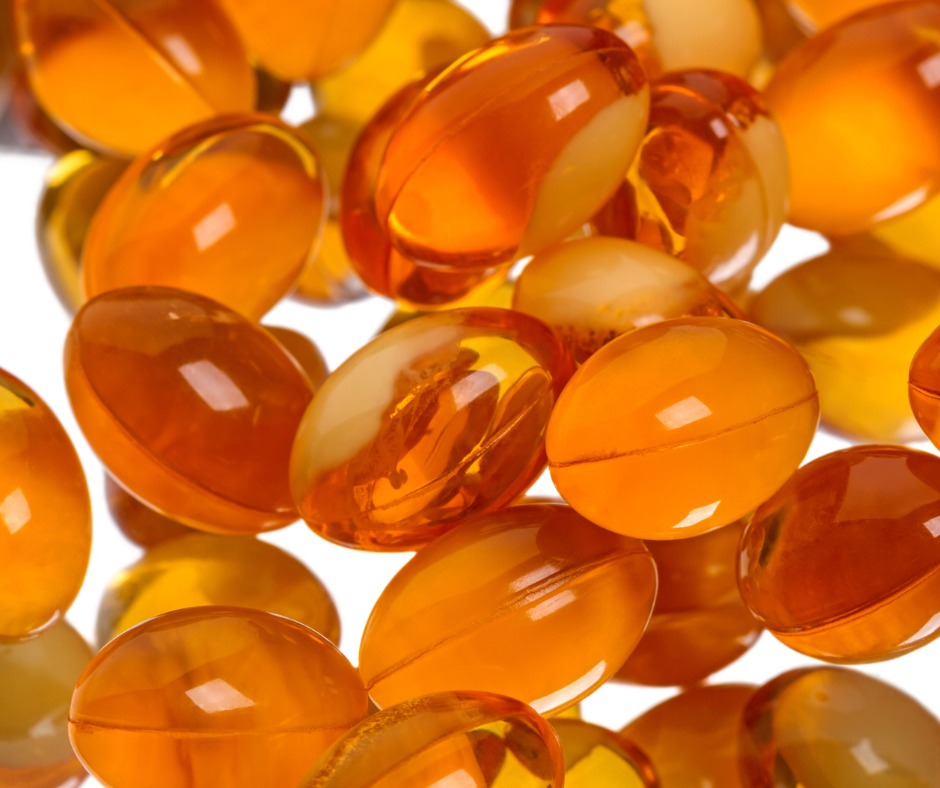
Looking for the best cod liver oil? Not all cod liver oil brands are the same. I researched 10 different brands and found only one that stands head and shoulders above the rest as the best cod liver oil on the market.
Here is what I found:
- Most cod liver oil brands are overpriced because they are low in nutrition. This is due to the way they are processed with high heat and distillation.
- Because of the processing, most brands add synthetic vitamins to the oil.
- Only one brand is raw, safely processed, with no added nutrients or flavors.
- One brand should be avoided at all costs due to possible rancidity.
2023 Update: I originally wrote this post in 2017 but I have reviewed and updated and republished it for 2023. I still stand by the research I did back in 2017.
I Recommend Cod Liver Oil – But Not Just Any Brand
I highly recommend cod liver oil because it is a supplement that provides more vitamin D, vitamin A, omega 3 fatty acids than just about all other dietary supplements.
Whether you are experiencing joint pain, or want to improve brain function, increase hair growth or bone density, CLO is the one supplement that gives you the best vitamin intake in a very concentrated form. More so than all other dietary supplements.
In this post, I’ll tell you which cod liver oil supplements I recommend and why.
I’ll also tell you which brands I do not recommend and why.
Jump down to the brands I recommend
Jump down to the brands I do NOT recommend
Please note: I have affiliate links in this post. I make a small commission when you order via my affiliate links. However, I only recommend brands I trust. Thank you for helping to support my blog.
Why I Wrote This Article
I researched and wrote this article because I wanted to find out what is the best cod liver oil.
Cod liver oil has numerous health benefits. But it’s hard to know which CLO has the most nutrition.
And there’s really no other reason to buy cod liver oil — it’s not like you’re buying a CLO brand for the taste. So you should choose the one that has the most nutrition.
I used to rely on the Weston A. Price Foundation website for recommendations for the best cod liver oil supplements. Ever since the fermented CLO scandal in the fall of 2015, I can no longer trust the Weston A. Price Foundation recommendations.
Note: The content about the FCLO scandal was taken down from my site and the videos were all removed from YouTube due to Big Tech censorship. They didn't censor my FCLO content – they just took down my channel. But I had to move my site due to being censored, and now I have to fix all the links and republish all my posts... and it's taking forever. I will be putting these posts and videos back up soon and will link from here so if you are interested in learning more about the FCLO scandal, bookmark this page and check back.
Anyway, I spent a lot of time looking into cod liver oil supplements and searching for the best cod liver oil.
I wanted to share what I now recommend, as I have spent a great deal of time talking to cod liver oil and fish oil manufacturers and experts.
In this post, I start by going over the reasons to take cod liver oil, then I talk about the processing and manufacturing of cod liver oil, then finally I will go through a comparison of different cod liver oil supplements including my recommendation for the best cod liver oil supplements.
Jump down to the brands I recommend
Jump down to the brands I do NOT recommend
Why Take Cod Liver Oil?
Before I get into the comparison of cod liver oil brands, let’s first spend a few paragraphs covering why you should take it in the first place.
There are 3 reasons to take cod liver oil: vitamins A and D, and omega 3 fatty acids.
Vitamins A and D: We Need Ten Times More
Dr. Weston Price, author of Nutrition and Physical Degeneration, found that people in isolated traditional cultures who experienced optimal health consumed 10 times more vitamins A and D than people in his day in America (1930s).
The people Dr. Price studied had perfectly straight, white teeth with almost no cavities. They had no degenerative disease. They didn’t need eyeglasses or braces, didn’t suffer from infertility, and had no birth defects in children.
Vitamins A & D are both critical for bone health as well as for a healthy immune system, which we need now more than ever. Our immune system is weakened by all kinds of things, from v@ccine shedding to chemtrails to toxic food and polluted water.
In our modern day, Americans consume even less of vitamins A and D, since we no longer eat a lot of pastured lard (pig fat), seafood, egg yolks, butter, cream, and liver, and organ meats.
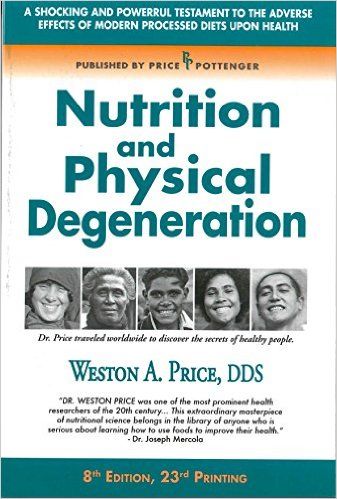
Dr. Weston Price specifically talked about how hard it is to get adequate vitamin D in the diet:
“With the remote possibility of egg yolks, butter, cream, liver and fish it is manifestly impossible to obtain any amount of vitamin D worthy of mention from common foods.” — Dr. Weston Price, Nutrition and Physical Degeneration
Vitamins A and D work together synergistically, and it’s important to consume them in the right ratio. Too much vitamin A is toxic to human health.
Most of us are not eating pastured lard and liver regularly anymore. Traditionally in America, prior to the 20th century, people ate lard (one of the best sources of vitamin D) daily and they ate liver only once a week, which ensured they weren’t getting too much A. Lard was the primary cooking fat back then.
We also used to get a lot more sun. Most people farmed in the 19th century and prior, so they spent a lot more time outdoors. We also didn’t use sunscreen and we work in offices all day and can’t get out to sunbathe.
If you don’t want to cook with lard or eat copious amounts of butter and cream and cheese every day and eat liver once a week, the easiest way to increase vitamins A and D in your diet is to supplement with 1 teaspoon of quality CLO per day (1/2 teaspoon for children and 1/4 teaspoon for babies).
Vitamin A has also been shown to be incredibly beneficial for people on the autism spectrum. Please check out pediatrician, Dr. Mary Megson’s work.
Omega 3 Fatty Acids: They’re Essential!
In addition to vitamins A and D, we also need omega 3 fatty acids. We’ve all heard about the benefits of anti inflammatory fatty acids, also known as omega-3s.
This is why baby formula contains docosahexaenoic acid (DHA) and eicosapentaenoic acid (EPA) -- because they are essential nutrients.
Eicosapentaenoic acid (EPA) is an omega-3 fatty acid that is found along with docosahexaenoic acid (DHA) in cold-water fish, including tuna and salmon. The correct balance of these nutrients are what create anti inflammatory properties.
The body can’t manufacture them, which is why they’re called “essential fatty acids”. Health authorities around the world recommend taking 250-500 mg of omega-3s (EPA and DHA) per day.
Health Benefits of Omega-3 Fatty Acids
- Heart health
- Lower triglycerides
- Reduce joint pain and stiffness
- Reduce depression
- Strengthen immune system
- Improve eye health
- Improve joint health
- Lower blood pressure
- Brain health – prevent Alzheimer’s disease and dementia
- Mental health -- prevent anxiety and ADHD
- Critical for making healthy, smart babies
Omega-6 to Omega-3 Ratio: Out of Whack
Most of us are not getting the amount of omega-3 fatty acids that we used to.
The ideal ratio of omega-6 fatty acids to omega-3 should be about 4 to 1, which is close to the ratio humans evolved with. Today that ratio has morphed to about 20 to 1. This is because agriculture has moved from a pasture-based model to a confinement (CAFO, or confinement animal feeding operation) model.
Omega-3 fatty acids are produced by animals eating grass. Fish get their omega-3s from grass — sea grass, that is, as well as algae, other sea vegetables.
Oily fish like sardines and anchovies, and the fish that eat them, are great sources of the two healthiest forms of omega-3 fatty acids, docosahexaenoic acid (DHA) and eicosapentaenoic acid (EPA).
Cows also get their omega-3 fatty acids from grass. Unfortunately most cows today are fed corn. The reason most beef, chicken, pork, dairy and eggs are lacking omega-3s is because feed cows and chickens a factory diet of corn and grain — foods these animals don’t normally eat.
Corn oil has an omega-6-to-omega-3 ratio of about 45 to 1. As a result of an unnatural diet of cheap corn, cows have very little omega-3s in their milk, cheese or meat.
Grass-fed meat and dairy is rich in omega-3 fatty acids. Pastured chickens that are allowed to scratch outdoors for grass, seeds and insects produce eggs rich in DHA.
Bonus: I’ve noticed that when I’m eating a lot of omega-3 fatty acids, I rarely get a sunburn. We’ve found this to be true with several members of our family. And this is obviously an advantage because if you don’t use sunscreen, you will absorb more vitamin D when you do get sun exposure. Sunscreen reduces vitamin D absorption in the skin by more than 95%. (Source)
The easiest way to increase your ratio of omega-6s to omega-3s is to take a CLO supplement. Ideally you also want to eat grass-fed meat and dairy and seafood as well.
What about just eating fish? Couldn't you just eat fresh fish to get enough essential fatty acids? You could, but it can be difficult for most people. Most people don't eat a balanced diet to begin with, and few people eat enough seafood.
I think of CLO as an insurance policy, since I can’t always eat grass-fed meat and dairy when I eat at restaurants, etc. Also, I know I don’t always eat as much seafood as I should.
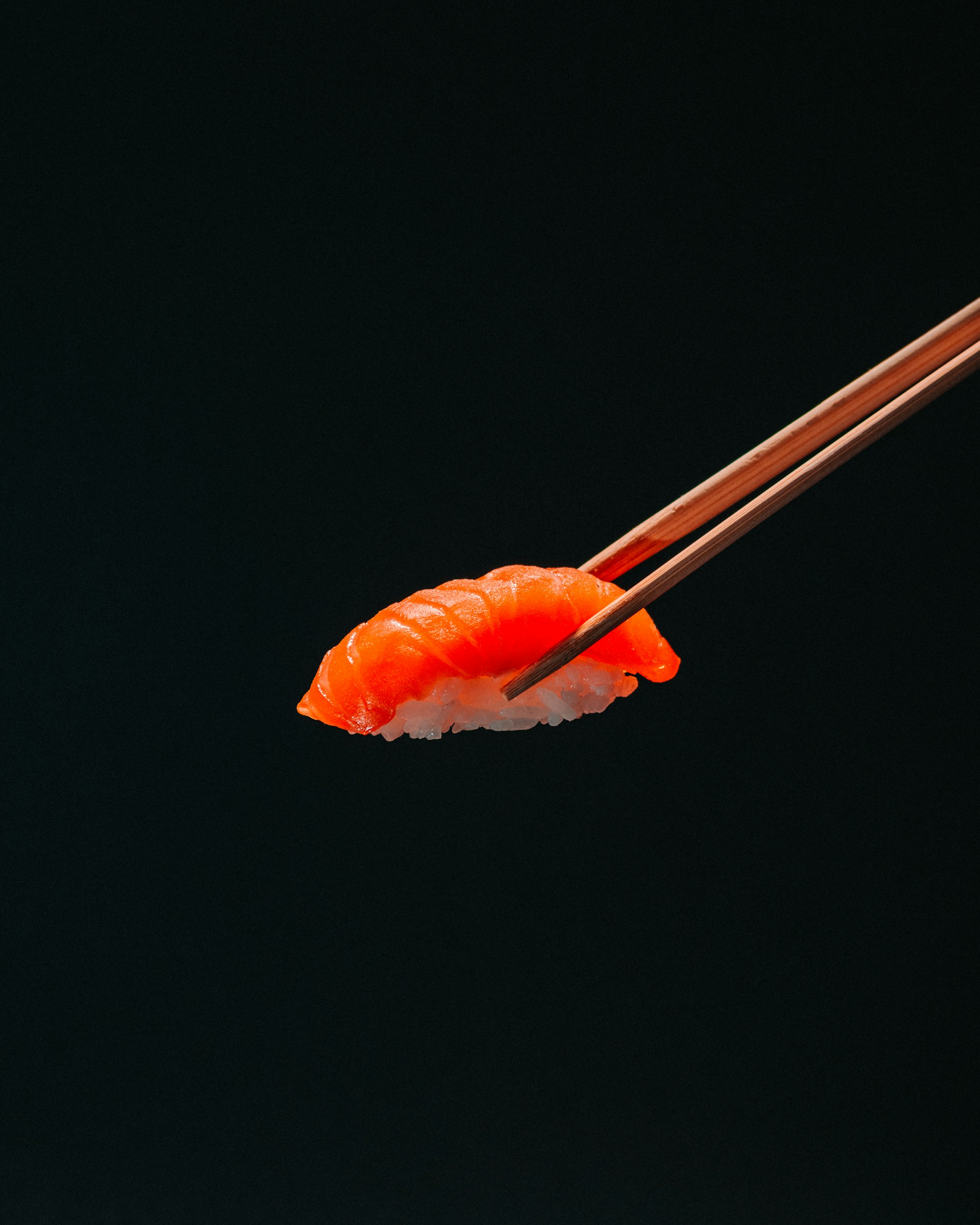
Can't We Just Take Fish Oil Supplements?
Fish oil has taken the health and wellness world by storm. But no, they are not the same as CLO and I don't recommend them.
They are good for you because of the essential fatty acids, however, they do not contain vitamin A. For this reason, CLO is better.
Best Cod Liver Oil? The Raw Milk Analogy
When shopping for the best fish liver oil, one way to think about it is to compare it to shopping for milk. According to Grist, “Like many other modern foods, most of the milk sold today has been altered, stripped, and reconstituted.”
When you buy milk, you have to know your farmer. You need to know the cows, how they are fed, whether they eat grass or grain, if they are eating organic or if they are eating pesticides.
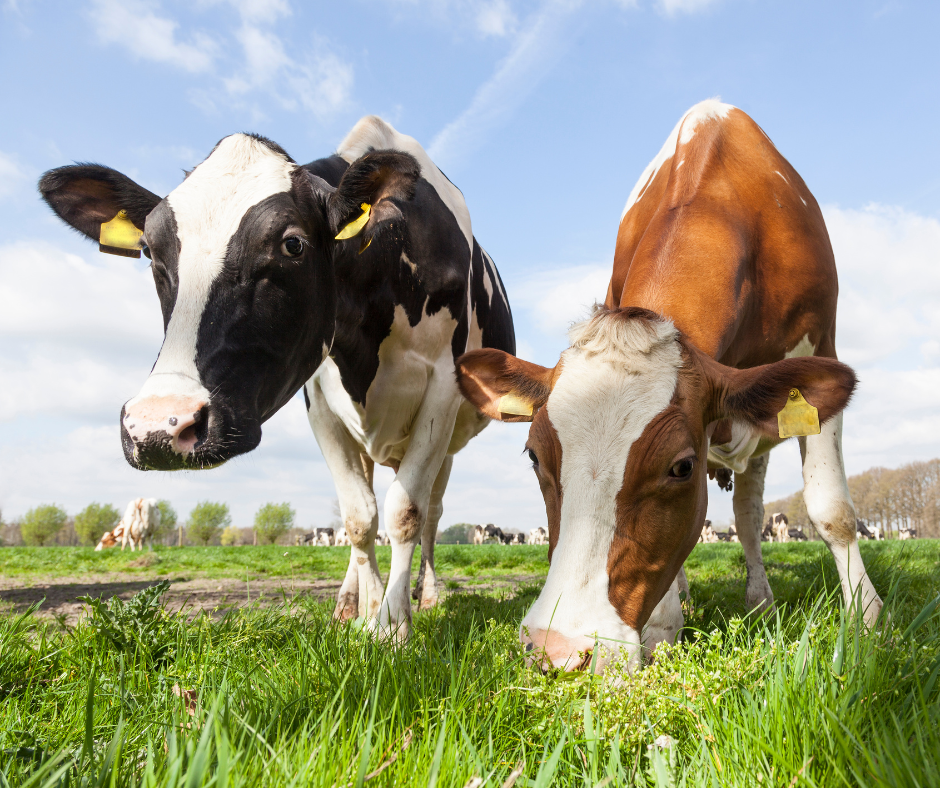
You need to know if they are given antibiotics or growth hormones. You also need to know if the fat is removed from the milk, and if it is heated (pasteurized) and/or homogenized. All of these things factor into the quality of the milk. You can buy different types of milk and some are much better than others. Some types of milk can be actually harmful to your health.
Raw organic whole milk from grass-fed cows is the best and I highly recommend it. Skim milk from cows eating grain is the worst, and I wouldn’t waste your money buying it — you may as well drink water.
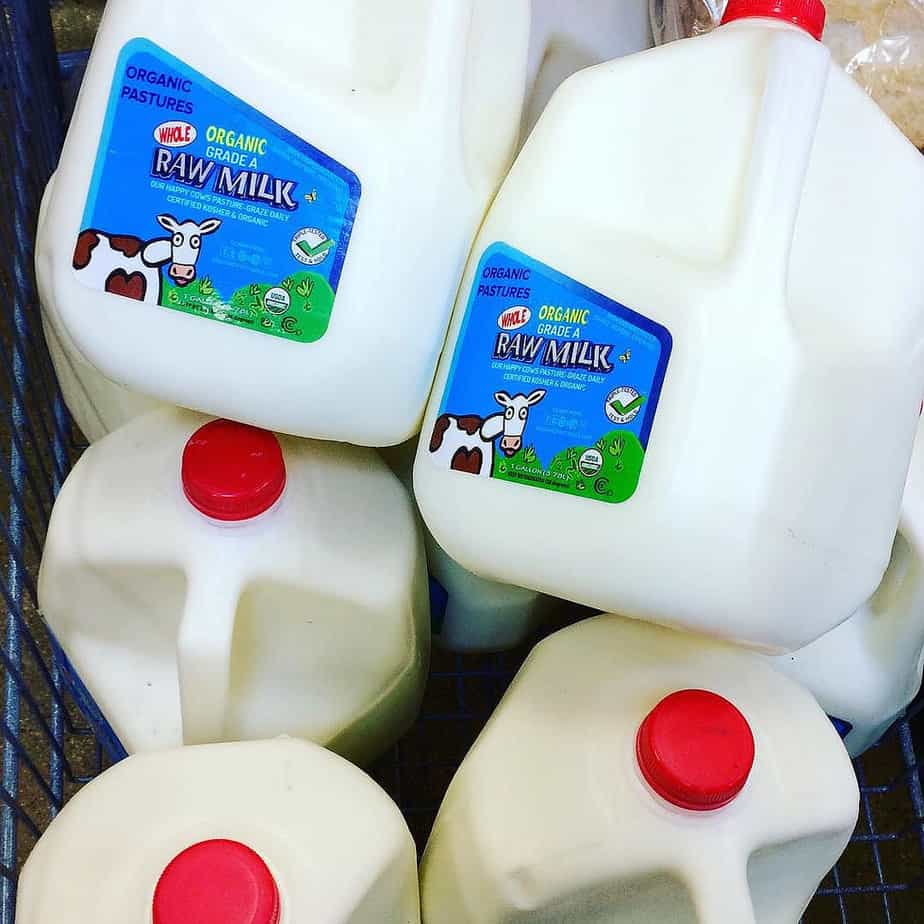
I’ll explain in detail…
Best (Recommended): Raw Milk from Grass-fed Cows
The best kind of milk is raw milk that is not homogenized and pasteurized, and is from cows that are grass-fed. All the natural vitamins are intact and the milk has higher levels of vitamins because the vitamins have not been destroyed by heat (pasteurization).
Raw milk also contains the living bacteria that produces the enzyme lactase that digests lactose. (This is why many people who cannot digest milk due to lactose intolerance find that they can drink raw milk.)
Second Best (Recommended if You Can’t Get Raw Milk): Organic Whole Milk from Grass-fed Cows That is Pasteurized But Not Homogenized (Cream-top Milk)
Whole milk from grass-fed cows that has been pasteurized will lose some of the vitamin content. Pasteurization also destroys bacteria that produce enzymes. This makes milk harder to digest.
Homogenization is not recommended because it causes the fats to become oxidized or rancid. Also, most brands of milk, even organic milk, add vitamins to their milk and they are not required to list that they do.
Look for whole milk that is lightly pasteurized and not homogenized from grass-fed, pasture-raised cows. Avoid ultra-pasteurized (UHT, or ultra high-temperature processing) milk.
Third Best (Not Recommended): Whole Milk (Not Grass-fed), Organic or Conventional, Pasteurized and Homogenized
Organic, pasteurized whole milk from cows eating organic grain instead of grass does not have the many health benefits of grass-fed dairy. Grass-fed dairy is much higher in vitamin K2, which is produced when cows eat green grass, and grass-fed dairy is higher in omega-3s.
But the biggest problem with this milk is the homogenization oxidizes the fat (i.e. it becomes rancid and toxic). You’re paying a lot for organic (I don’t recommend drinking conventional, non-organic milk due to the pesticides and fluoride) and is it really worth it when you are getting a lot less nutrition? I say, if you want to drink milk, pay more for organic whole milk that is grass-fed and preferably raw. Otherwise, don’t buy milk.
Fourth Best (Not Recommended): Skim Milk (Not Grass-fed), Organic or Conventional, Pasteurized and Homogenized
Reduced fat milk or skim milk from cows eating or organic grains or non-organic grains is what I call “white water”.
This milk is totally worthless. The pasteurization of the milk destroys the vitamins, the grain instead of grass means even fewer vitamins, and removing the fat means you lose everything. They have to add synthetic ingredients to make up for what they took out.
Lastly, if it’s not organic, then you’re getting all the pesticides, too. But even if it is organic, that just means you’re overpaying.
Bottom line: Skip it. Don’t waste your money. You may as well drink water, which is free.
How Cod Liver Oil is Manufactured
OK, so now that you understand how to buy the most nutritious milk, let’s look at how cod liver oil is manufactured. Just like modern milk is stripped, refined and reconstituted, modern cod liver oil goes through similar processes.
The big question is this: Why would you buy cod liver oil for nutrition when it’s not really very nutritious?
Just like you want to know your dairy farmer, you need to know your CLO manufacturer. You want to know what species of fish they are using and where they are caught, you need to know how the oil is extracted, how the impurities are removed, and how the oil is bottled, and whether any vitamins are added, and finally, what amounts of vitamins the CLO contains, based on independent testing.
Let’s discuss a few of these so that you know what you’re looking at when we get to the CLO brand comparisons below…
Sourcing of Fish
You need to know where and how the fish are sourced. Farmed fish are totally different than wild fish, and farmed fish are not recommended.
You also want to make sure you’re buying cod liver oil from a company that fishes sustainably. In other words, they’re not hurting sea turtles and sharks in the process of fishing for cod.
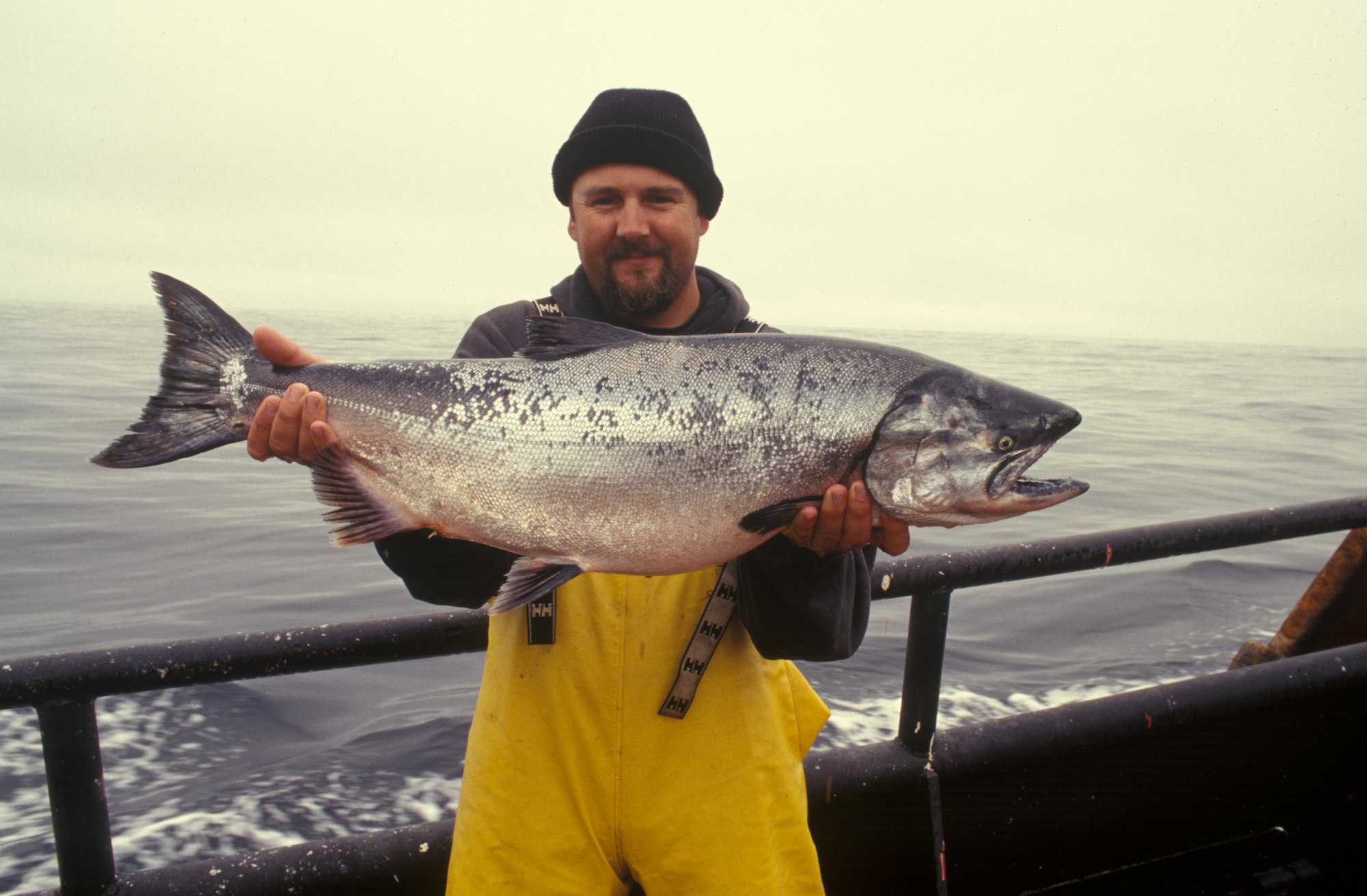
Which Species of Cod?
This is important because different fish have different nutritional profiles. It’s not just important to get CLO that comes from the cod family, you need to know the species. Gadus morhua is Atlantic cod, whereas Gadus macrocephalus is Pacific cod.
Almost all cod liver oils on the market say they are made from Atlantic cod.
Green Pasture’s fermented cod liver oil (FCLO) is the only one that uses Pacific cod.
Protection from Rancidity During Processing
The process of manufacturing cod liver oil has a lot of steps and there are important reasons why they do it the way they do. The most important thing is that the CLO is not rancid. Rancid, or oxidized marine oil is extremely toxic and causes serious health problems. Marine oil becomes oxidized very quickly when exposed to light, heat and air.
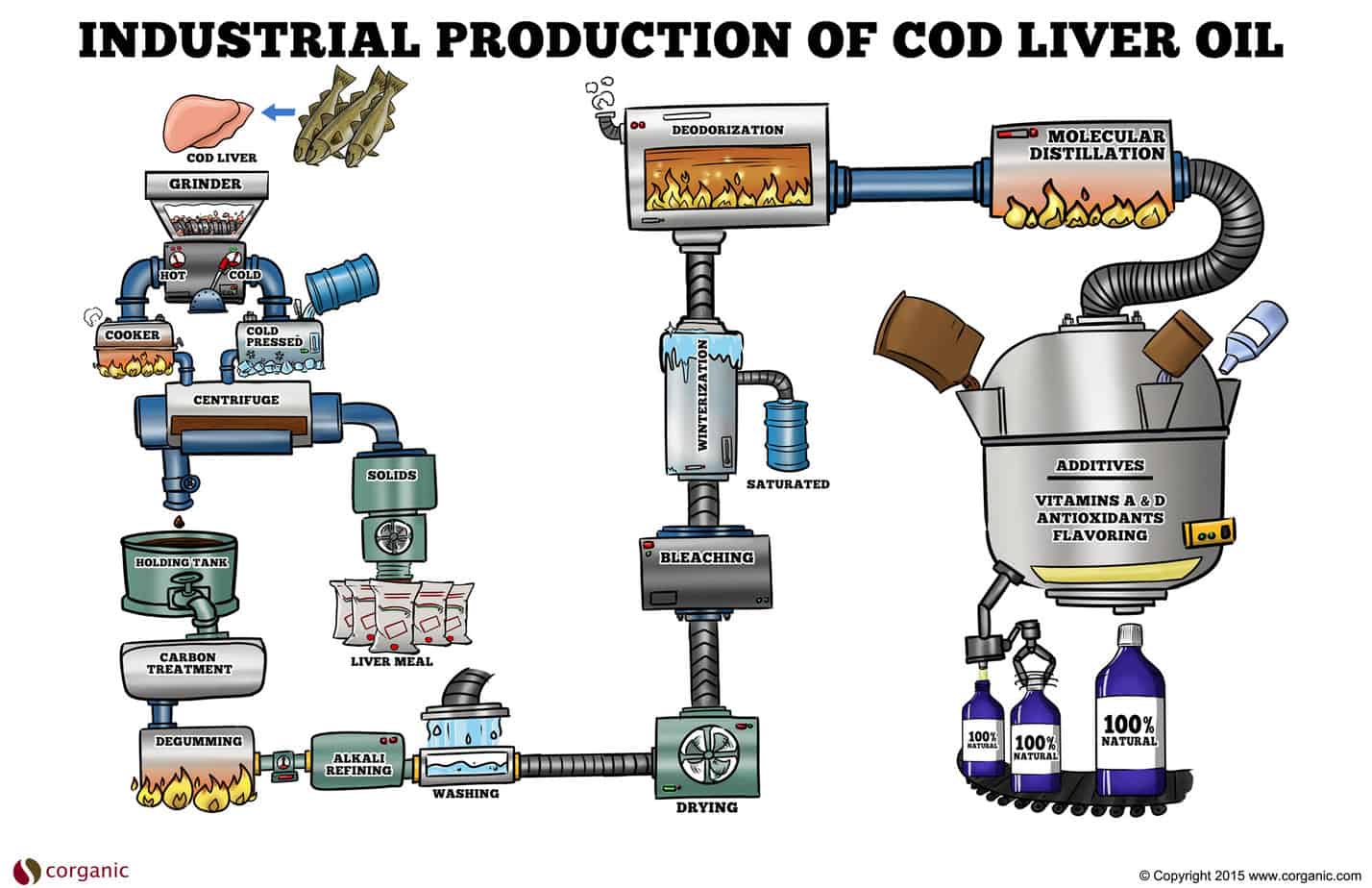
For this reason, during processing, cod liver oil must be protected from exposure to heat light or air. How long it takes to get the fish liver oil from the ocean to the bottle is really important. It’s also important how it’s done. If it’s exposed to oxygen and light, the fragile oil will be damaged. Think of it this way… you wouldn’t want to buy milk from a farmer who let it sit out all day at room temperature.
There are many ways to protect the cod liver oil supplement from light and air… For example, the manufacturing plant should have low lighting. Antioxidants are added to help slow the oxidation of the oil.
There should be a process in place to remove the air out of the bottle during bottling. The bottles should be dark to protect the oil from light. The same goes for cod liver oil capsules — they do it in such a way that there’s no air in the cod liver oil capsules.
Other Concerns During Processing
While it is extremely important to protect the oil from rancidity, we also want a cod liver oil with minimal processing in order to maintain the naturally occurring vitamins. Most modern cod liver oils on the market use industrial processing.
Almost all CLO manufacturers use heat to extract the oil and they use industrial processes to make it palatable — for example, winterizing and deodorizing. Almost all marine oil manufacturers also use molecular distillation to filter the impurities from the oil.
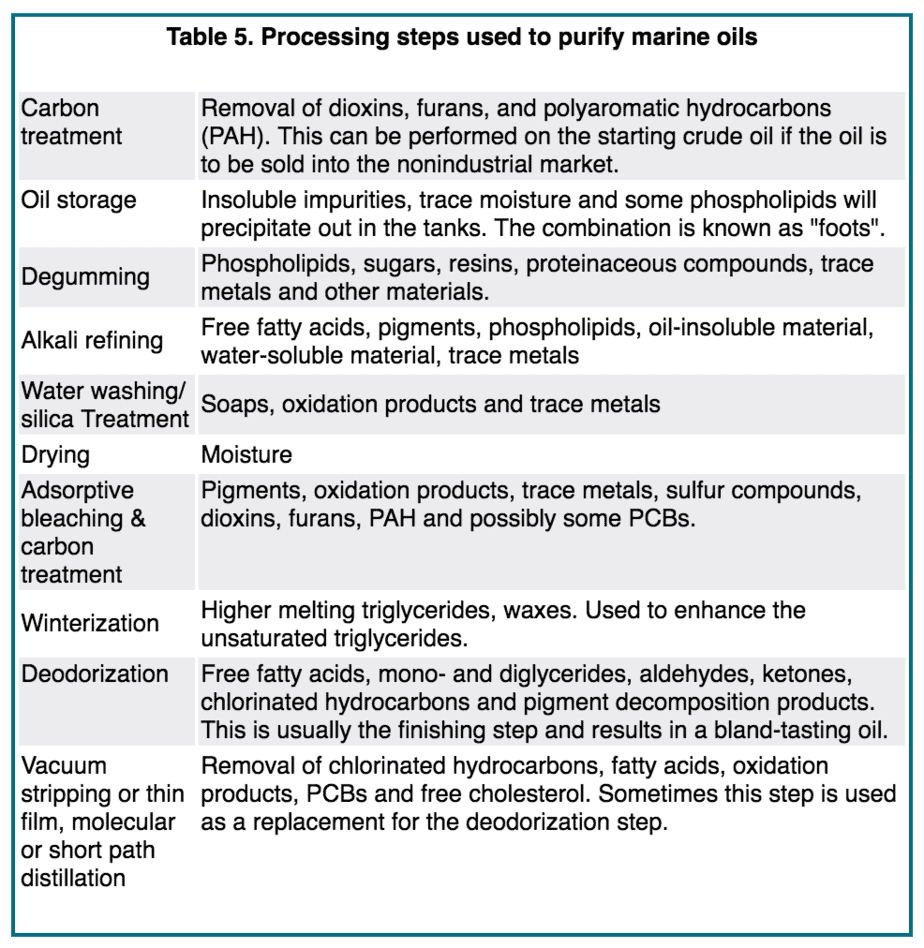
When you heat CLO, or any fish oil supplement, it destroys the naturally occurring vitamins, and it ends up just like pasteurized homogenized skim milk. For this reason, almost all cod liver oil brands add back natural and vitamins to the industrially processed oil.
Best Cod Liver Oil Supplements I Recommend
Okay, so let’s get on with the recommendations.
1. Best Cod Liver Oil: Rosita EVCLO (Extra Virgin Cod Liver Oil)
The best cod liver oil, and the only brand that I recommend, is Rosita EVCLO.
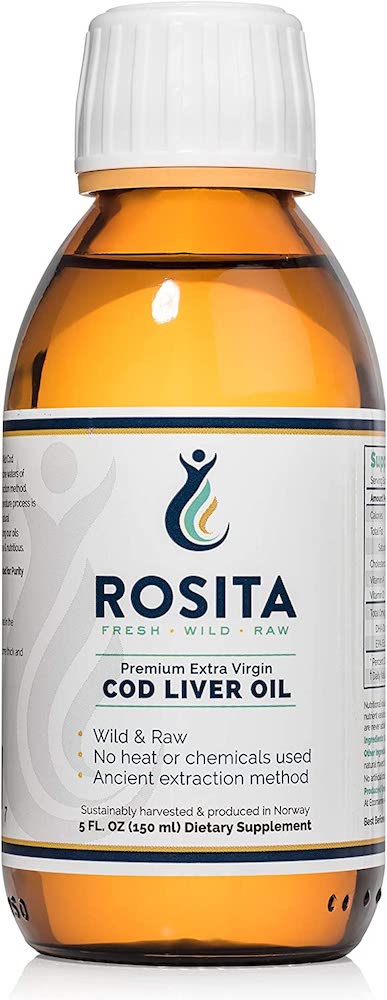
Ingredients
100% Wild & Raw Extra-Virgin Cod (Gadus Morhua) Liver Oil (plus tiny amounts of rosemary & natural vitamin E as antioxidants)
- Vitamin A: 2171-2962 IU
- Vitamin D: 145-389 IU
- Ratio of Vitamins A & D: Somewhere between 14:1 to 7:1 (right around 10:1)
- Total Omega-3s: 1060 mg
- EPA: 443
- DHA: 605
- Other Omega-3s: Not listed
- Antioxidant Added: Yes
- Fish Species: Wild Gadus Morhua (Atlantic cod)
- Origin of Fish: Norway
- Extraction: Cold extraction (not heated)
- Vitamins: Naturally occurring. No vitamins are added, except the vitamin E which is an added antioxidant to protect the oil from rancidity.
- Nutrition Data: Source
- Testing: 3rd party independent, published online here
- Cost Per Bottle: $49 for 5.07 ounces
- Cost Per Ounce: $9.66 per ounce
- Cost Per Serving (1 Teaspoon): $1.61
Where to Buy: Buy Rosita EVCLO Online
You get the liquid EVCLO or EVCLO in capsule form. I used to take the liquid cod liver oil, but it’s so much more convenient to take the cod liver oil capsules so that is what I take now.
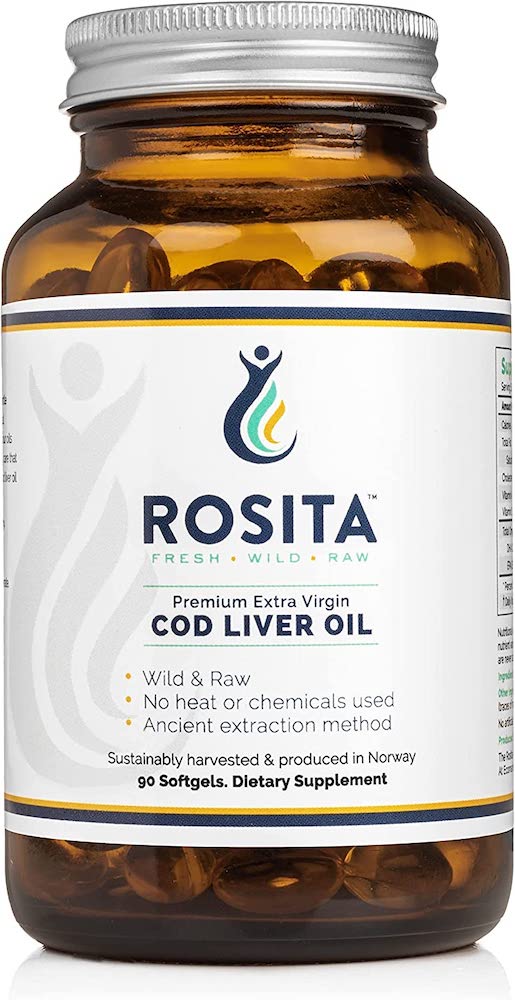
Vitamin A & D Ratio
The vitamin A/D ratio of Rosita EVCLO is excellent, right around 10:1.
They list a range of vitamins for A and D. This is a big indicator that these are naturally occurring vitamins from the wild caught fish, not added natural or synthetic vitamins. With added vitamins, you’ll almost always see exact numbers that look too perfect, like they’re cheating on a test.
So their A/D ratio could be as high as 14:1 and as low as 7:1 — but we’ll call it in the middle, which is right around 10:1.
Sourcing of Fish
Rosita is extremely transparent about where they source their fish, which is in Norway. The making of this oil is a very old and traditional health remedy in Northern European societies, particularly in Norway. Children always took their daily dose of this oil.
They use a sustainable method of fishing wild Arctic cod with their own fishing boats which you can read about on their website.

In fact, my friends Dan, Archie and Karen who run Organic 3 (the United States importers of Rosita EVCLO), go to Norway every year and they go fishing for cod on Rosita’s fishing boat. That’s them in the photo above. Talk about knowing your farmer, or fisherman, as it may be.
Processing
Rosita also uses the methods I discussed above as far as fast processing from ship to bottle, using low lighting in the manufacturing plant, etc. Rosita is the only CLO brand I know of that uses an old method Viking method of extracting the oil.
Instead of using heat, they take the livers from a cold environment and move them to room temperature. The oil releases from the livers very quickly, and then they’re able to process the oil for impurities, and then they bottle it.
Rosita EVCLO is not heated for extraction or for the molecular distillation, which is how almost all other cod liver oils are processed to remove impurities. This is why Rosita EVCLO is the only raw CLO on the market that I know of.
Since it is raw and unheated, all the vitamins -- essential nutrients -- are naturally from the fish. No vitamins are stripped away, so nothing synthetic is added.
They also have a process to remove heavy metals and other toxins. There are no genetically modified organisms in the product either.
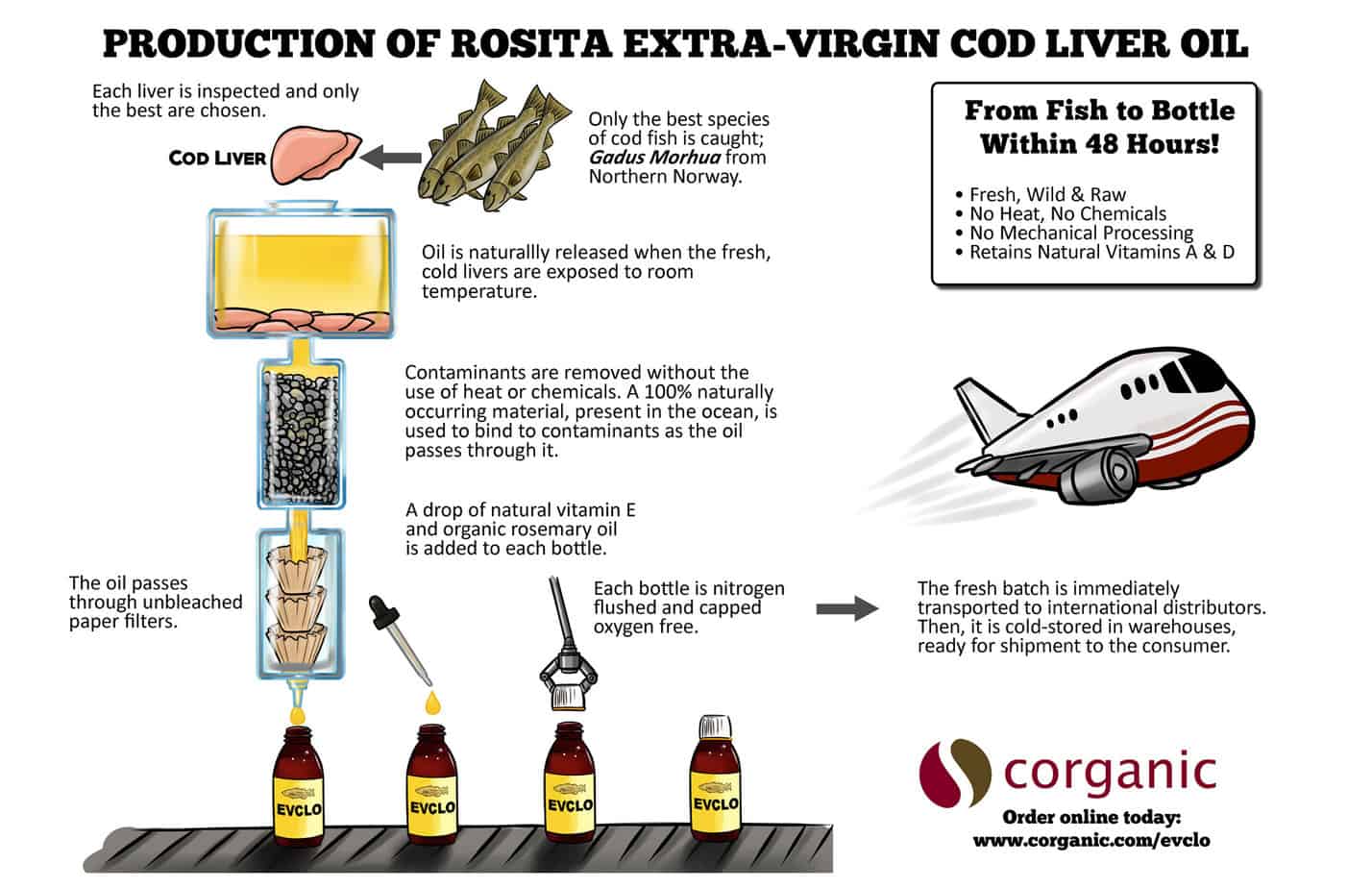
Added Vitamins?
The fact that there is a range of vitamins A and D listed is an indication that Rosita EVCLO is not adding synthetic vitaminsvita A and D. When vitamins are added, you will see exact numbers for A and D, not ranges.
Watch for this in the examples of below of the industrial cod liver oil brands I do not recommend.
Added Flavors?
Rosita does not add artificial flavors, or any flavors for that matter, to their cod liver oil. It has a very mild seafood taste with no fishy taste or fishy aftertaste.
The reason they do not add flavoring is they believe it is important not to camouflage the taste in any way, as consumers need to be able to tell if the oil has oxidized (gone rancid).
Where to Buy Rosita:
Buy Rosita EVCLO Liquid
Buy Rosita EVCLO Capsules
Cod Liver Oil Brands I Do Not Recommend
Let’s talk now about all the other brands out there that I do not recommend. I listed all the nutrition data and information about sourcing, processing, etc. for each one so you can compare for yourself. Since this is such a long post, I numbered them so you can keep track.
To make all this info easier to navigate, here is the list of the 9 brands of CLO I don’t recommend (you can jump down to each review by clicking the link):
1. Nordic Naturals Arctic
2. Nordic Naturals Arctic-D
3. Carlson’s
4. Dropi
5. Garden of Life
6. Sonne’s
7. Twinlab
8. NutraPro
9. Green Pasture Fermented Cod Liver Oil
1. Nordic Naturals
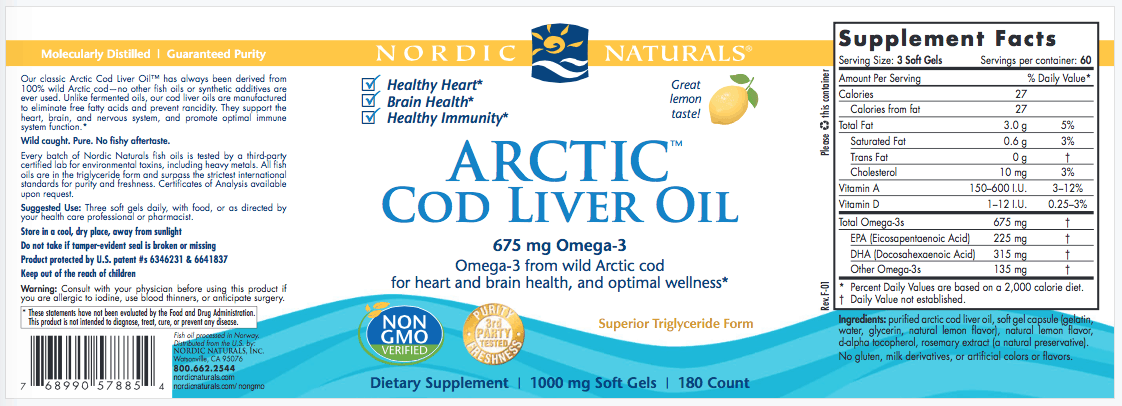
Nordic Naturals Arctic Cod Liver Oil is their basic cod liver oil brand. They have another formulation with added vitamin D, Arctic-D Cod Liver Oil, which I will talk about below.
This is the best cod liver oil brand from the list of supplements that I don’t recommend. So while I do not recommend this brand, it would be the best choice if you could not get Rosita.
I like them because they are very transparent about how they source their fish, they are big proponents of sustainable fishing, and they are very adamant about not adding any synthetic vitamins to their cod liver oil. They don’t call other brands out, but they make a big deal about it on their website and marketing materials, which the other cod liver oil brands don’t.
You can also see from their numbers that they have a range for vitamins A and D, not exact numbers. Exact numbers are a sign that the company is adding synthetic and/or natural vitamins to the oil.
However, I do not recommend the Arctic Cod Liver Oil. The biggest reason is the ratio of vitamins A and D. The ratio for the Arctic Cod Liver Oil is 57:1 which is very high in vitamin A. Again, we are looking for a ratio of around 10:1 or less. I’ll discuss this more below…
Ingredients
Purified Arctic cod liver oil, natural fruit flavor, d-alpha tocopherol (natural vitamin E), rosemary extract (a natural preservative).
- Vitamin A: 230-920 IU
- Vitamin D: 0-20 IU
- Ratio of Vitamins A & D: 57:1
- Total Omega-3s: 1060 mg
- EPA: 340
- DHA: 510
- Other Omega-3s: 210
- Antioxidant Added: Yes
- Fish Species: 100% wild Arctic cod (Skrei)
- Origin of Fish: Norway
- Extraction: Heat extraction
- Vitamins: Naturally occurring. No vitamins are added, except the vitamin E which is an added antioxidant to protect the oil from rancidity.
- Nutrition Data: Source
- Testing: 3rd party independent, referenced online here
- Cost Per Bottle: $25.95 for 8 ounces
- Cost Per Ounce: $3.24 per ounce
- Cost Per Serving (1 Teaspoon): $0.54
Vitamin A & D Ratio
Too high in vitamin A, not enough D: 57:1.
Sourcing of Fish
Excellent, totally transparent and invested in sustainable fishing. They only use wild-caught Arctic cod.
Processing
This is an industrially processed cod liver oil, which is what almost all cod liver oils are (except Rosita EVCLO).
They use heat extraction and molecular distillation, just like everybody else does. This is why the vitamins A and D are so much lower than you get with Rosita EVCLO.
Because of the modern industrial processing this brand uses, Rosita EVCLO has 4 times more vitamin A and over 50 times more D than Nordic Naturals Arctic Cod Liver Oil.
Added Vitamins?
No added vitamins. This is a good thing. But because the vitamin A and D are so low due to the industrial processing, there is no real advantage taking cod liver oil over regular fish oil (which I also don’t recommend due to the same kind of industrial processing). And, as I said above, the A/D ratio is wrong.
Added Flavors?
Yes. Not ideal, because it’s harder to tell when the product goes rancid.
2. Not Recommended: Nordic Naturals Arctic-D
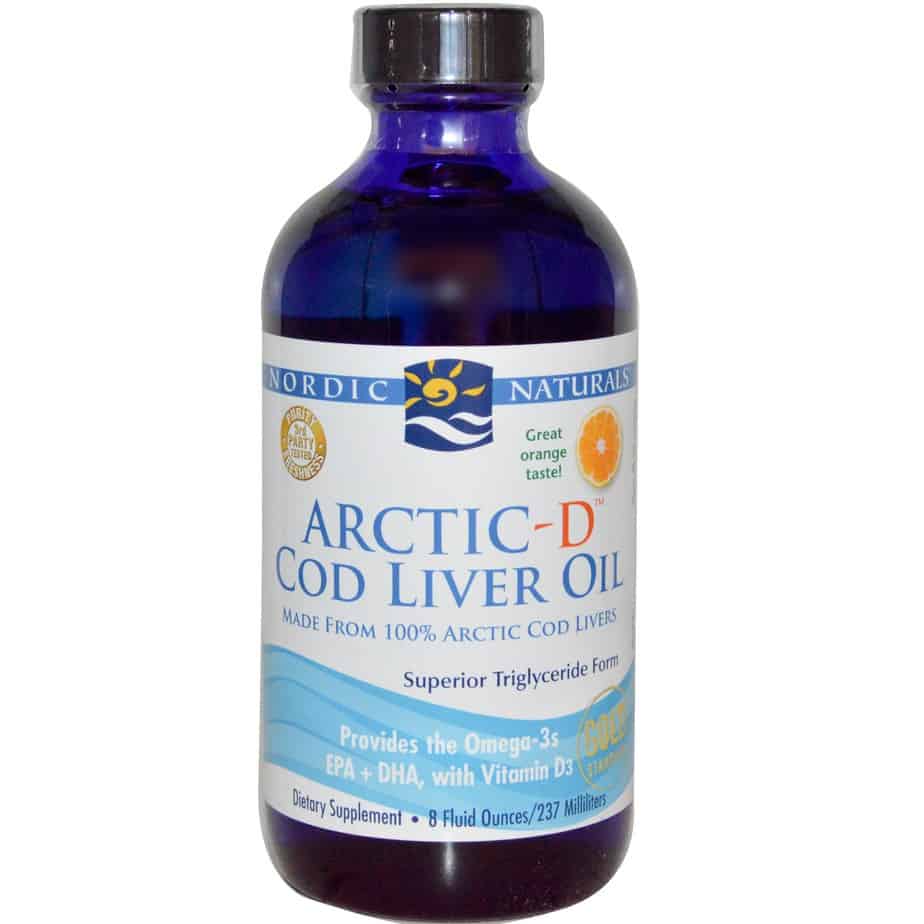
Nordic Naturals Arctic-D Cod Liver Oil is the cod liver oil brand with added natural D.
Everything I said above about the Arctic Cod Liver Oil applies, with two differences: (1) The Arctic-D has added D3, so it has more D than the other formulation and (2) it has a different ratio of vitamins A/D.
That said, I do not recommend Arctic-D Cod Liver Oil. The biggest reason is the ratio is screwy: .6/1. Now we have too much D and not enough A. This is much better than adding vitamin A, which some of the other brands use (you’ll see below). But it’s still too much D.
Also we need to talk about the natural vitamin D they are adding. The D they are adding is the natural form of D3, cholecalciferol.
Cholecalciferol is a natural form of D, and is infinitely better than the version of vitamin D2, ergocalciferol. Ergocalciferol is made from mushrooms and recent studies show that people with higher levels of D2 in their blood have more psychosis and schizophrenia. D2 is not a vitamin that any human should be consuming.
D3 from cholecalciferol, on the other hand, is the form of D that comes from animals.
There is no plant-based form of D3. D3 comes from either fish or from sheep’s wool.

The cholecalciferol used as D3 supplements in vitamins, including Arctic-D Cod Liver Oil, is made from a waxy substance called lanolin, which is an oil extracted from sheep’s wool. They also use lanolin for lip balm and nipple cream.
However, most of the crunchy breastfeeding moms I know won’t use lanolin nipple cream, due to concerns about pesticides.
According to Leah Segedie’s blog, Mamavation:
“…the biggest danger of lanolin is that sheep are sprayed directly with pesticides to treat mites and pests. In addition, harvested fur is treated again with pesticides during refinement. Lanolin can legally contain up to 40 parts per million (ppm) of pesticides to be FDA-compliant. This is interesting to note because lanolin that is reserved for hospital use on open wounds is regulated to no more than 3 ppm of pesticides.”
Of course, I understand this concern, as the potentially pesticide-laden lanolin in nipple cream is something you would not want your newborn baby consuming.
As for the cholecalciferol from lanolin inD3 supplements… I don’t have a problem eating “sheep wax”… I mean, I eat bone marrow and blood sausage and gelatin and all kinds of stuff like that…
And you only need a very small amount of cholecalciferol from lanolin to get vitamin D3.
While I would rather get D3 from fish as nature intended, it can be hard to get enough D3 from fish oil in winter, particularly in areas of the world where it is impossible to get D from the sun in winter (anywhere north of 37 degrees latitude).
Anyway, my bottom line on this is while I don’t think it’s bad to take cholecalciferol from lanolin to get D3 (I do it when I am low and can’t get enough sun), I don’t see the point of buying a cod liver oil to get vitamin D when the fish oil has been heated, the natural vitamin D3 has been destroyed, and cholecalciferol has been added.
You may as well take D drops, which costs a fraction of what this cod liver oil costs.
This brand of D3 drops costs 2 cents per 1000 IU D3, versus this cod liver oil which costs 56 cents per 1000 IU D3.
Ingredients
Purified Arctic Cod Liver Oil, Natural Lemon Flavor, D-Alpha Tocopherol, Rosemary Extract, Vitamin D3.
- Vitamin A: 230-920 IU
- Vitamin D: 1000 IU
- Ratio of Vitamins A & D: .6:1
- Total Omega-3s: 1060 mg
- EPA: 340
- DHA: 510
- Other Omega-3s: 210
- Antioxidant Added: Yes
- Fish Species: 100% wild Arctic cod (Skrei)
- Origin of Fish: Norway
- Extraction: Heat extraction
- Vitamins: Naturally occurring. No vitamins are added, except the vitamin E which is an added antioxidant to protect the oil from rancidity and D3 sourced from sheep’s wool.
- Nutrition Data: Source
- Testing: 3rd party independent, referenced online here
- Cost Per Bottle: $26.95 for 8 ounces
- Cost Per Ounce: $3.37 per ounce
- Cost Per Serving (1 Teaspoon): $0.56
Vitamin A & D Ratio
Very low vitamin A and too high in D: .6:1.
Also, the D3 is not from fish, it’s from sheep’s wool (lanolin). See above.
Sourcing of Fish
Same as Nordic Naturals Arctic above.
Processing
Same as Nordic Naturals Arctic above.
Added Vitamins?
Same as Nordic Naturals Arctic above.
Added Flavors?
Same as Nordic Naturals Arctic above.
3. Not Recommended: Carlson Cod Liver Oil
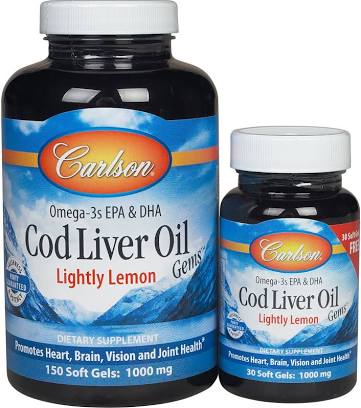
I do not recommend Carlson Cod Liver Oil because it is industrially processed with heat and molecular distillation, the naturally occurring vitamins are destroyed, and they add back in natural D3 (cholecalciferol, from the wax in sheep’s wool, known as lanolin — see above re: pesticides in lanolin) and vitamin A (retinyl palmitate).
So… I need to talk a little bit about added vitamin A (retinyl palmitate) and why it’s a non-starter.
Known as retinyl palmitate and retinol palmitate, synthetic vitamin A palmitate is added to reduced-fat and skim milk, and is also added to low-fat yogurts, cereals and other foods and lots of skin care products. In fact, there was a brouhaha recently over retinyl palmitate in sunscreen.
Ann Marie Gianni explains: (excerpted — go to her site to read the whole thing)
“Both retinol and retinyl palmitate are widely used ingredients in skin care products. Both are forms of vitamin A. Retinol is a pure form of the vitamin found in green and yellow vegetables, egg yolks, whole milk, beef, chicken, and fish-liver oil. It’s essential to vision and bone development and plays a role in vision health. Retinol is also hugely popular in skin care products because the skin naturally converts it to retinoic acid, which helps to stimulate collagen production, increase cellular rejuvenation, and decrease pore size, creating softer, smoother skin.”
The concern about retinyl palmitate in sunscreen (or in other products, really) came about when the EWG, a non-profit organization, highlighted a 2009 animal study by the National Toxicology Program (NTP).
The conclusions: retinoic acid enhanced the photocarcinogenic activity of UVB rays in the mice and increased multiplicities of skin lesions. Retinyl palmitate also enhanced photocarcinogenicity, increased skin lesions, and increased the presence of squamous cell neoplasm’s—the beginnings of skin cancer.
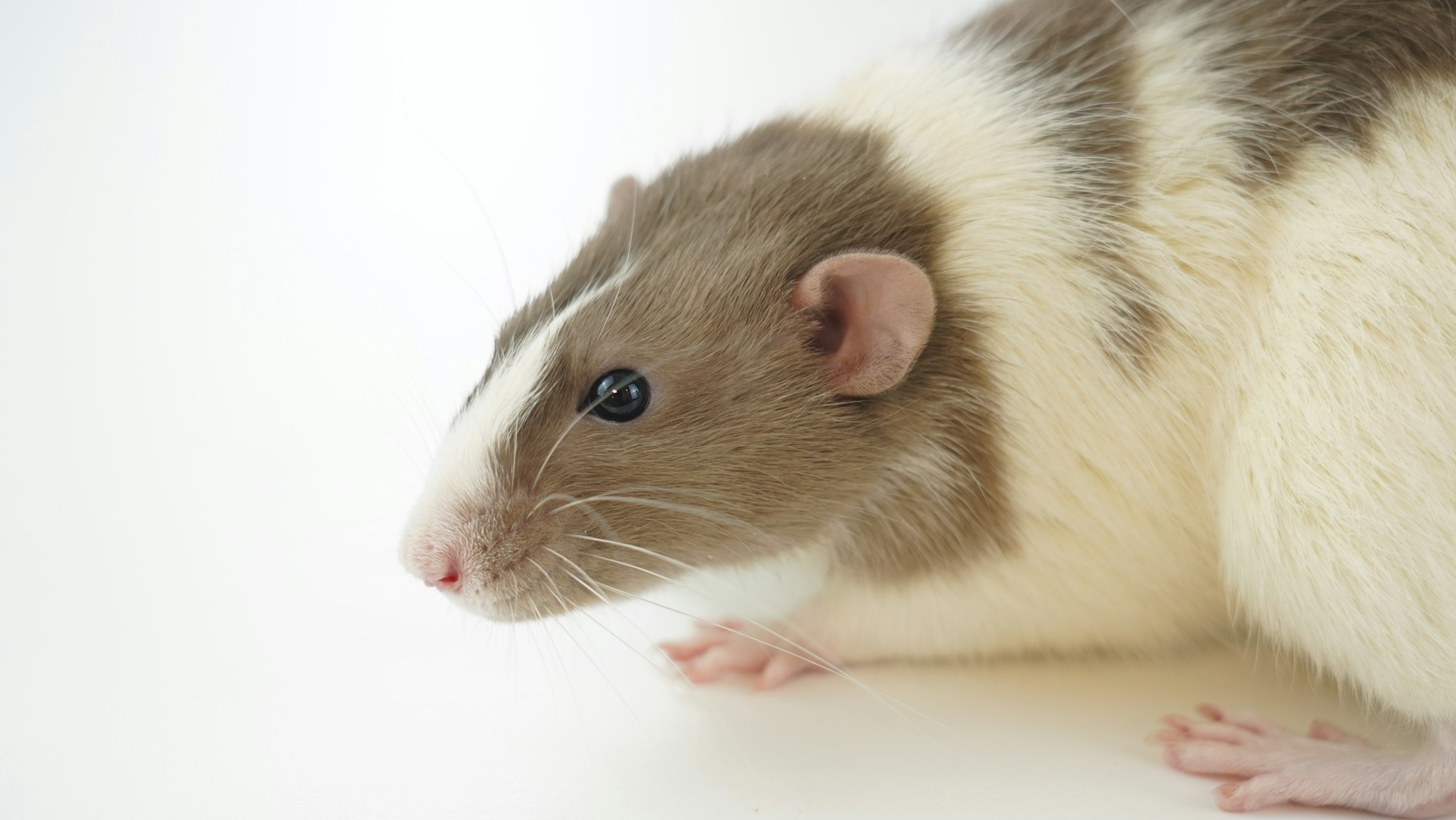
This study actually confirmed the results of other research. In 2006, for instance, scientists found in laboratory studies that when subjected to UVA light, retinyl palmitate acted as a “photosensitizer,” leading to free radical formation and the peroxidation of fatty cells.
Another study in 2005 found the same thing.
Researchers wrote: “These results suggest that RP [retinyl palmitate] is photomutagenic in combination with UVA exposure in mouse lymphoma cells….” In other words, when retinyl palmitate was exposed to UV rays, it created changes in the skin that could lead to damage, aging, and cancer.
Do I need to go on? Or actually, I should say, does Ann Marie (the other Ann Marie) need to go on? I think not.
Bottom line: We do not want to take a cod liver oil with vitamin A added.
We may not know if this causes cancer or not… but even if it is safe, it’s a man-made vitamin.
I’d rather get my vitamin A from natural sources such as egg yolks, liver and seafood. Or from cod liver oil that is not processed in a way that destroys the natural vitamin A that was there to begin with.
Ingredients
100% Norwegian Carlson Cod Liver Oil, Natural Lemon Flavor, Vitamin E
- Vitamin A: 850 IU
- Vitamin D: 400 IU
- Ratio of Vitamins A & D: 2:1
- Total Omega-3s: 1100 mg
- EPA: 400
- DHA: 500
- Other Omega-3s: None listed
- Antioxidant Added: Yes
- Fish Species: 100% Norwegian Cod
- Origin of Fish: Norway
- Extraction: Heat extraction
- Vitamins: Vitamin E is added, as well as natural D3 (cholecalciferol, from sheep’s wool) and synthetic vitamin A (retinyl palmitate).
- Nutrition Data: Source
- Testing: 3rd party independent, referenced online here
- Cost Per Bottle: $32.90 for 8 ounces
- Cost Per Ounce: $3.89 per ounce
- Cost Per Serving (1 Teaspoon): $0.65
Vitamin A & D Ratio
They have a 2:1 ratio which is a little too good if you ask me. In the video I made above, I talked about how when a student cheats on a test, teachers often know because their answers are too perfect.
But the 2:1 ratio makes sense when you see that they are adding vitamins, natural D3 (cholecalciferol, from sheep’s wool) and vitamin A (retinyl palmitate). They can make the ratio come out to be whatever they want.
You will see this with all the other industrial cod liver oil brands to follow. The ratio is just too perfect. This is a sign that they are adding vitamins.
Sourcing of Fish
It says on their website, “At Carlson Cod Liver Oil, we ensure maximum freshness by managing our fish oils from sea to shelf. We source only the highest quality, deep, cold-water fish using traditional, sustainable methods, and all fish oil products are bottled or placed in soft gels with a touch of natural vitamin E to prevent oxidation.”
Processing
See above (sourcing). That’s all they say about how the manufacture the fish oil.
Added Vitamins?
See above. Added vitamins, natural D3, synthetic A, and natural vitamin E.
Added Flavors?
Yes.
4. Not Recommended: Dropi
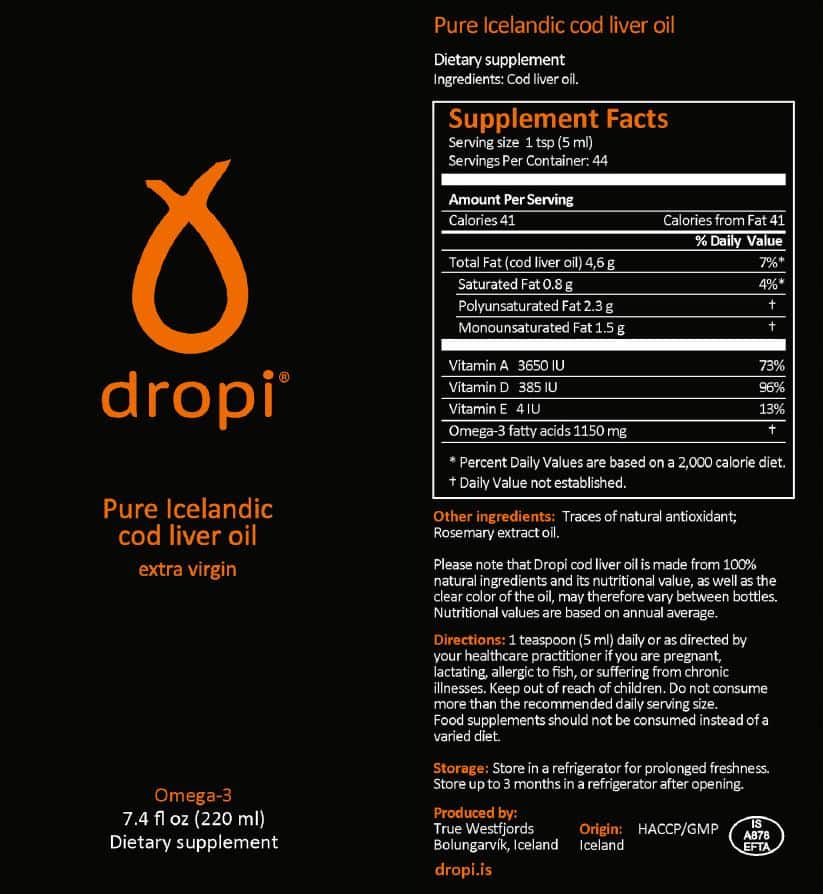
I don’t recommend Dropi for a number of reasons (see my detailed explanation below).
Before I can recommend this product, I would need to know more about the sourcing of the fish, the processing and manufacturing, and the testing.
UPDATE (10/27/16): Here is my update on Dropi cod liver oil.
Ingredients
Cod Liver Oil, Vitamin E, Traces of Natural Antioxidant, Rosemary Extract Oil
- Vitamin A: 3650 IU
- Vitamin D: 385 IU
- Ratio of Vitamins A & D: 9:1
- Total Omega-3s: 1150 mg
- EPA: 350
- DHA: 450
- Other Omega-3s: 350
- Antioxidant Added: Yes
- Fish Species: Icelandic cod (Gadus morhua)
- Origin of Fish: Northwest Iceland
- Extraction: Low heat extraction (?)
- Vitamins: They say they do not add vitamins A and D and only add “traces of natural antioxidant” and “rosemary extract oil” as antioxidants.
- Nutrition Data: Source
- Testing: Dropi says they do independent testing but the results are not posted online. Why?
- Cost Per Bottle: $46.99 for 7.44 ounces
- Cost Per Ounce: $6.32 per ounce
- Cost Per Serving (1 Teaspoon): $1.05
Vitamin A & D Ratio
A 9:1 ratio is great. But I’m skeptical because I don’t have enough info.
Sourcing of Fish
I can’t find any information on their website about how they are doing the sourcing. They say they are fishing in Iceland, which is great, but I want more information re: their methods of sustainable fishing.
Rosita is transparent about the fisherman that catch their fish, the boats they use, etc.
I would need to know more about Dropi’s sourcing before I could recommend them.
Processing
I want to know more about how they do this. How do they extract the oil? If Dropi is using the same method as Rosita, why not say so?
On the Dropi website, it says:
“Dropi oil is produced in a very gentle way and the idea is based on the old tradition. Low temperatures are used in the process to maintain all the natural properties of this valuable oil, therefore we can consider Dropi extra virgin cod liver oil and RAW food.”
They also say:
“We use low temperature in the process to maintain all the natural properties of the oil. Our production is dependent on nature, e.g. weather, circumstances at the Ísafjarðardjúp fishing grounds, and fish population.”
I am curious about this “old tradition” they speak of. Are they doing what Rosita is doing, processing the livers without heat? If so, why don’t they say that? Rosita tells us everything about how they make EVCLO. So the method is not proprietary. Why not share on the website what the extraction process is?
Furthermore, they don’t say how they purify the oil. How do they get the contaminants out? Again, if you scroll up, Rosita tells us how they purify their EVCLO, and they post very detailed lab results from third-party testing.
Dropi, on the other hand, does not post their lab tests. Which makes me suspicious. Why not post them like Rosita does?
Added Vitamins?
They say “We DO NOT add any vitamin A (palmitate) or vitamin D (calciferol) to our precious oil.” That’s great. Just need to know how they are doing it.
They do add “traces of natural antioxidant” and “rosemary extract oil” for an antioxidant, which is good.
Added Flavors?
No.
5. Not Recommended: Garden of Life
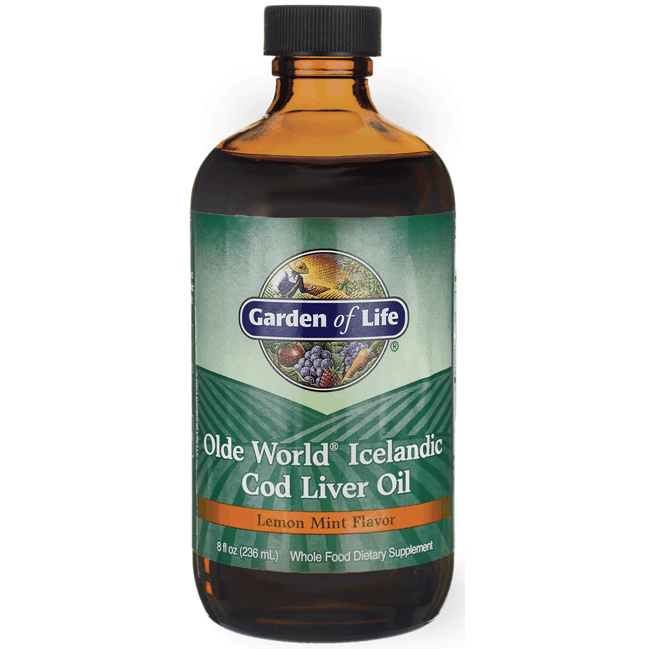
I do not recommend Garden of Life cod liver oil for all the same reasons I do not recommend Carlson’s (see above). It’s industrially processed oil extracted with heat and they use molecular distillation.
So that means they have to be adding vitamins. You can’t get a ratio like this without adding back vitamins if you are using heat and molecular distribution.
Ingredients
Cod Liver Oil, Natural Lemon Essence, Natural Peppermint Essence, Alpha Tocopherol
- Vitamin A: 4,500 IU
- Vitamin D: 450 IU
- Ratio of Vitamins A & D: 10:1
- Total Omega-3s: 1400 mg
- EPA: 447
- DHA: 400
- Other Omega-3s: 594
- Antioxidant Added: Yes
- Fish Species: Icelandic Cod
- Origin of Fish: Iceland
- Extraction: They don’t say. All they say is “processed using traditional methods”
- Vitamins: Vitamin E is added. It doesn’t say on their label but they have to be adding vitamins A and D.
- Nutrition Data: Source
- Testing: Nothing on their website.
- Cost Per Bottle: $14.66 for 8 ounces
- Cost Per Ounce: $1.83 per ounce
- Cost Per Serving (1 Teaspoon): $0.31
Vitamin A & D Ratio
10:1 ratio – too perfect. As we have seen above, this is a sign that they are adding vitamins A and D. Otherwise, you don’t see perfect numbers like that.
They say on their website, “Olde World Icelandic Cod Liver Oil comes from the pure, cold waters of Iceland and is processed using traditional methods to ensure its naturally occurring vitamins and essential fatty acids remain intact.”
Sourcing of Fish
Nothing on their website other than “From the Pure, Cold Waters of Iceland”. Hmm…
Processing
Nothing on their website other than, “Olde World Icelandic Cod Liver Oil comes from the cold waters of Iceland and is processed using traditional methods.”
We’re going to need more information.
Added Vitamins?
See above. Most likely it’s added vitamins (A and D), and natural vitamin E.
Added Flavors?
Yes.
6. Not Recommended: Sonne’s
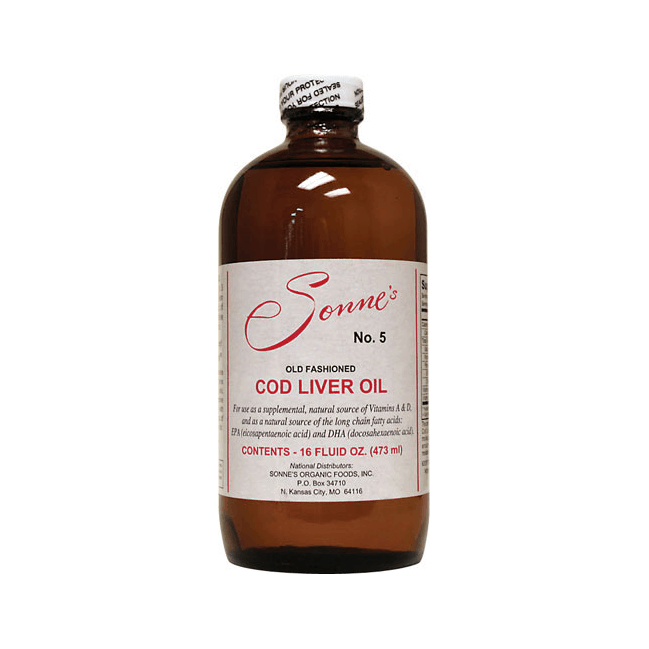
I do not recommend Sonne’s cod liver oil for all the same reasons I do not recommend Carlson’s (see above).
It’s industrially processed oil that's extracted with heat and they use molecular distillation.
So that means they have to be adding vitamins. You can’t get a ratio like this without adding back vitamins if you are using heat and molecular distribution.
Also, their EPA vs. DHA ratio is very suspicious. It should not have the exact same number for EPA as DHA.
This is the second cheapest product I reviewed, only .24 per teaspoon. I am extremely suspicious of this oil.
Ingredients
Norwegian Cod Liver Oil
- Vitamin A: 4000 IU
- Vitamin D: 400 IU
- Ratio of Vitamins A & D: 10:1
- Total Omega-3s: Not listed
- EPA: 440
- DHA: 440
- Other Omega-3s: Not listed
- Antioxidant Added: No
- Fish Species: Norwegian cod
- Origin of Fish: Norway?
- Extraction: They don’t say. All they say is “processed using traditional methods”
- Vitamins: It doesn’t say on their label but they have to be adding vitamins A and D.
- Nutrition Data: Source
- Testing: They say they do independent lab testing but they don’t link to any reports.
- Cost Per Bottle: $22.50 for 16 ounces
- Cost Per Ounce: $1.41 per ounce
- Cost Per Serving (1 Teaspoon): $0.24
Vitamin A & D Ratio
10:1 ratio – too perfect. As we have seen above, this is a sign that they are adding vitamins A and D. Otherwise, you don’t see perfect numbers like that.
Sourcing of Fish
The website says:
“Our Cod Liver Oil uses natural Norwegian cod liver oil derived from fish caught in open waters in the North Atlantic Ocean – away from sites of industrial pollution.”
Not enough information.
Processing
It doesn’t say anything about how they extract the oil. It does say, “This product is purified by molecular distillation.” If they are using molecular distillation, then that explains the 10:1 A/D ratio. They have to be adding vitamins.
We’re going to need more information.
Added Vitamins?
See above. Most likely it’s added vitamins (A and D).
They do not add antioxidants which is not good.
Added Flavors?
No.
7. Not Recommended: Twinlab
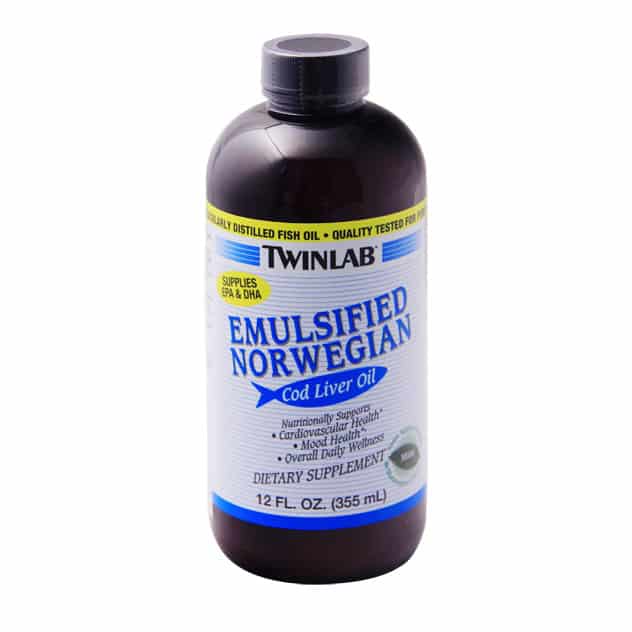
I do not recommend Twinlab cod liver oil for all the same reasons I do not recommend Carlson’s (see above). This is industrially processed oil that is extracted with heat and they use molecular distillation.
So that means they have to be adding vitamins. You can’t get a ratio like this without adding back vitamins if you are using heat and molecular distribution. Am I starting to sound like a broken record? 🙂
They don’t have a website I could find… so there’s very little information on them.
This is the cheapest product available, only .17 per teaspoon. I don’t trust it.
Ingredients
Cod Liver Oil
- Vitamin A: 4615 IU
- Vitamin D: 462 IU
- Ratio of Vitamins A & D: 10:1
- Total Omega-3s: 970
- EPA: 554
- DHA: 369
- Other Omega-3s: Not listed
- Antioxidant Added: No
- Fish Species: No idea
- Origin of Fish: Norway?
- Extraction: No information
- Vitamins: It doesn’t say on their label but they have to be adding vitamins A and D.
- Nutrition Data: Source
- Testing: Couldn’t find any information on this.
- Cost Per Bottle: $11.89 for 12 ounces
- Cost Per Ounce: $0.99 per ounce
- Cost Per Serving (1 Teaspoon): $0.17
Vitamin A & D Ratio
10:1 ratio – too perfect. As we have seen above, this is a sign that they are adding vitamins A and D. Otherwise, you don’t see perfect numbers like that.
Sourcing of Fish
No information.
Processing
No information.
Added Vitamins?
See above. Most likely it’s added vitamins (A and D).
They do not add antioxidants which is not good.
Added Flavors?
No.
8. Not Recommended: NutraPro
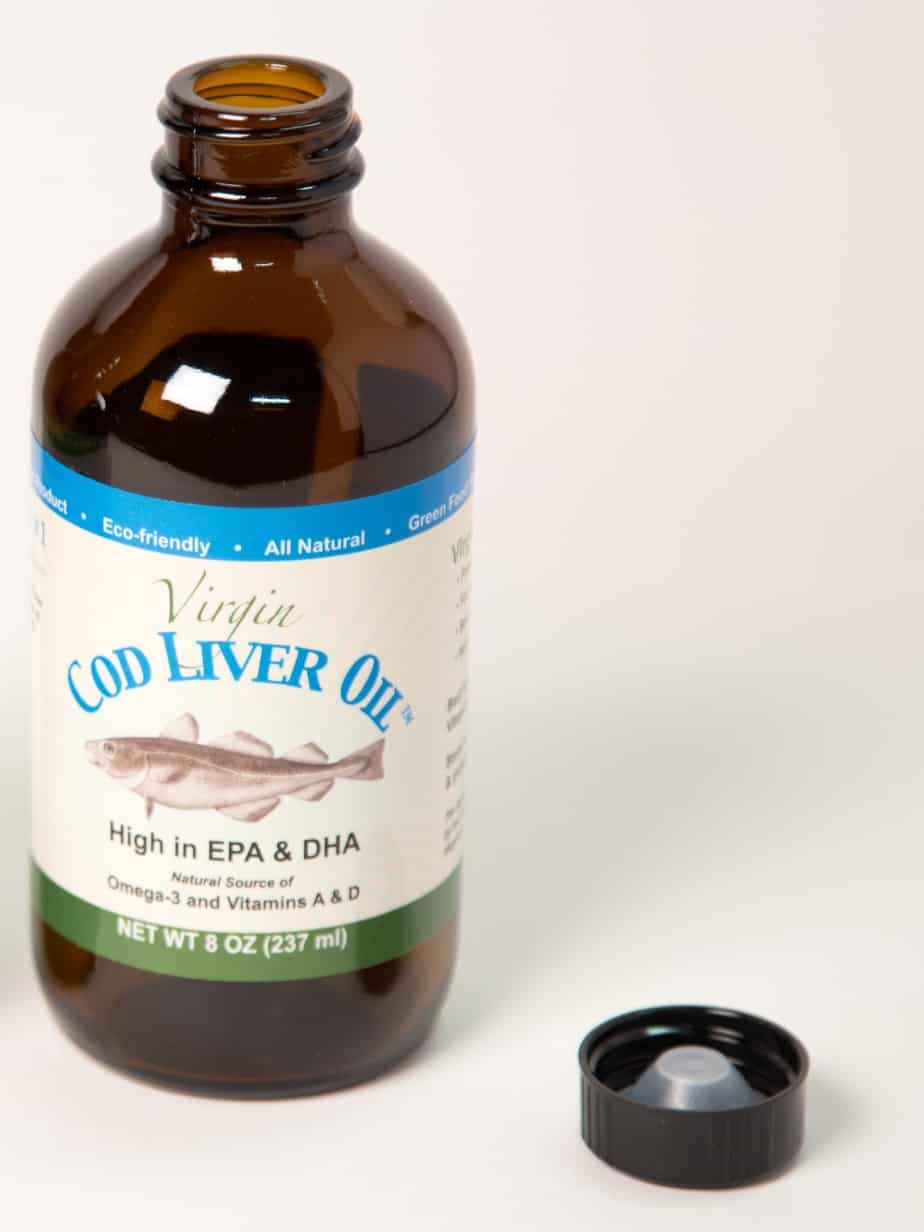
I do not recommend NutraPro for all the same reasons I do not recommend Carlson’s (see above).
They say on their website, “Virgin Cod Liver Oil is separated from fresh cod fish livers using cold pressed & advanced purifying technologies without the use of chemicals.”
Cold pressed and advanced purifying technologies? Let’s see more information about that.
Nothing on their website about their process and manufacturing. I’m guessing this is industrially processed oil that is extracted with heat and they use molecular distillation. Unless they say what they’re doing, I don’t believe it.
Especially because I recently discovered that the founder of this company is a registered sex offender.
Now, just because he is a convicted felon, does not mean he doesn’t make great cod liver oil. But let’s just say I’m a lot less likely to trust this person.
Plus, he started the company just months after he was arrested back in 2007, and he runs the company out of his residential suburban home. Zero info on how he sources or processes the fish.
And yeah, once again, the ratio is too perfect.
Ingredients
Virgin cod liver oil, natural vitamin E
- Vitamin A: 5000 IU
- Vitamin D: 500 IU
- Ratio of Vitamins A & D: 10:1
- Total Omega-3s: 1200
- EPA: 700
- DHA: 500
- Other Omega-3s: Not listed
- Antioxidant Added: Yes
- Fish Species: Atlantic cod (Gadus morhua)
- Origin of Fish: Norway?
- Extraction: They say on their website: “Virgin Cod Liver Oil is separated from fresh cod fish livers using cold pressed & advanced purifying technologies without the use of chemicals.” But they don’t say how they do it or go into any more detail than that.
- Vitamins: It doesn’t say on their label but they have to be adding vitamins A and D. I’m suspicious of that ratio.
- Nutrition Data: Source
- Testing: They say they do independent lab testing but they don’t link to any reports.
- Cost Per Bottle: $22.50 for 16 ounces
- Cost Per Ounce: $1.41 per ounce
- Cost Per Serving (1 Teaspoon): $0.24
Vitamin A & D Ratio
10:1 ratio – too perfect. As we have seen above, this is a sign that they are adding vitamins A and D. Otherwise, you don’t see perfect numbers like that.
Sourcing of Fish
The website says:
“At NutraPro International Virgin Cod Liver Oil is made using Atlantic cod (Gadus morhua). The Pacific cod (Gadus macrocephalus), found in the Eastern and Western regions of the Northern Pacific.”
Who does the fishing? Do they use sustainable fishing practices? How are the livers transported? Where does the manufacturing take place? Not enough information.
Processing
The website says:
“The fish is processed within 24 hours in effective and gentle manner. The oil is separated from fresh cod fish livers using cold pressed & advanced purifying technologies without the use of chemicals, to produce its exceptional fresh quality.”
I am very skeptical about this. If you are going to buck the trend of what every other cod liver oil manufacturer is doing, and make COLD PRESSED, RAW CLO, don’t you think you should go into more detail on your website? Especially when you are running this “international” company out of a suburban home in Utah?
I would need a LOT more information before I could ever recommend this cod liver oil.
Added Vitamins?
According to the NutraPro International website, they do not add vitamins:
“No, we do not add or take out any vitamins from our virgin cod liver oil. They are all naturally presented.”
Uh… nope. You do not get a ratio that perfect with naturally occurring vitamins. Just look at the ranges we saw from Rosita and Nordic Naturals (above).
I don’t believe this.
Added Flavors?
Yes, or you can get unflavored.
9. Not Recommended: Green Pasture Fermented Cod Liver Oil
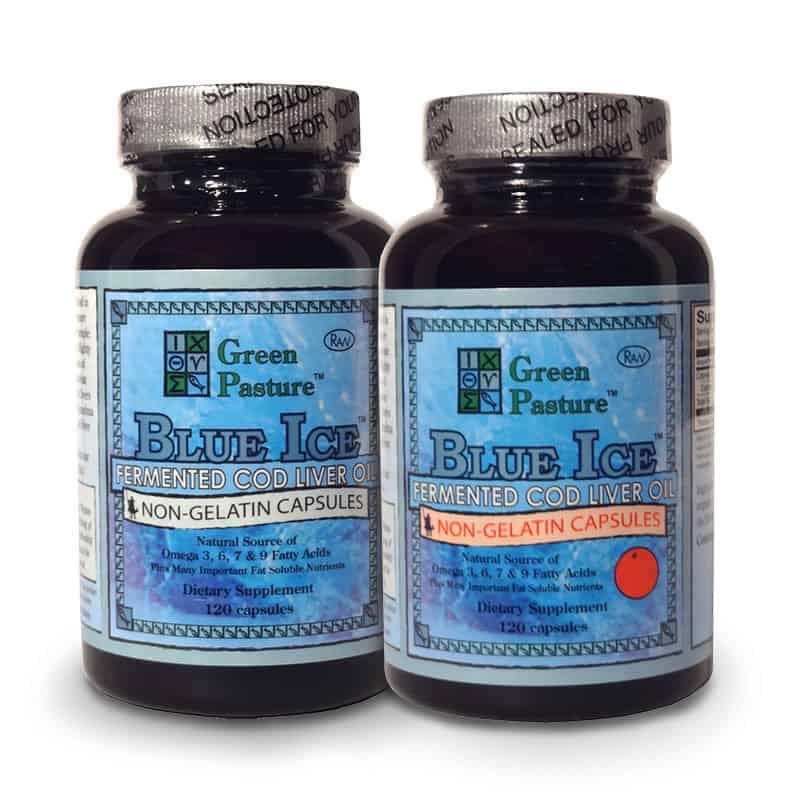
I do not recommend Green Pasture Fermented Cod Liver Oil for a whole host of reasons.
Most importantly because I believe it is probably rancid.
This is based on multiple sources of information, including Dr. Kaayla Daniel’s whistleblower report and all the research I did last fall, including interviewing fish oil experts and fish oil manufacturers.
You can read my whole series on the FCLO Scandal here.
Note: The links in this section don't work because I am going back and cleaning up all my old posts. I had to move from my old site due to Big Tech censorship. Check back or better yet, subscribe to my email updates so you get notified when I publish new posts.
Secondly, the ratio of vitamins A and D is crazily high: 53:1. This is based on the independent lab reports from Dr. Kaayla Daniel’s whistleblower report from August 2015, and also based on the independent lab reports the Weston A. Price Foundation presented in November 2015.
All the lab reports showed that Green Pasture Fermented Cod Liver Oil has a lot of vitamin A but almost no D.
Therefore it is not recommended, and shouldn’t even be recommended by WAPF. Why they are still recommending it, I do not know.
Thirdly, we also have almost no information about how the oil is processed. David Wetzel, owner of Green Pasture Products, has shared very little information about how the fermented CLO is processed. (See below.)
Fourthly, Wetzel is not adding an antioxidant. Almost every other CLO manufacturer uses an antioxidant to protect the oil from oxidation. I covered this issue in this post as well.
Fifthly, just check out all these reports of adverse health reactions from FCLO customers.
Finally (glad I didn’t have to say “sixthly” — and I probably shouldn’t say finally because I’m sure there are other issues that will come to me), why doesn’t Wetzel list nutritional and purity testing data on any of his labels or his website?
Why hasn’t WAPF, his biggest promoter, changed the nutritional information on their website?
Oh, and I just though of another reason I don’t recommend FCLO… As you can see below, you can’t find the amount of omega-3s for FCLO anywhere on their website or on their labels.
Why? Because… Wetzel has some crazy ideas about omega-3s. And I quote from the Green Pasture FAQ:
“We do not have a deep focus on the fatty acids in the FCLO because, over time and work, I have concluded that these fatty acids are not what the focal point of the product should be. The only reason EPA/DHA/Omega 3’s are discussed/pushed to the degree they are is after one completes the industrialization of these oils they have destroyed/damaged the real deal and they are left with some fatty acids. One always sells what they have. In the case of industrialized fish oils, fatty acids are about all that is left of value.”
He goes on and on about how you can calculate the omega-3s, but none of it makes any sense. There are a bunch of calculations with Xs and Ys and percentages. It’s nuts. Especially when every other CLO brand lists their omega-3 totals.
Super fishy, if you ask me. Avoid FCLO!
Ingredients
Fermented Cod Liver Oil, Organic Spearmint and Peppermint Oil, Organic Wintergreen Flavor Oil, Organic Lemon Oil
- Vitamin A: 3125 IU
- Vitamin D: 59 IU
- Ratio of Vitamins A & D: 53:1
- Total Omega-3s: Unknown (see above)
- EPA: Unknown (see above)
- DHA: Unknown (see above)
- Other Omega-3s: Unknown (see above)
- Antioxidant Added: No
- Fish Species: Pacific cod and pollock (Wetzel says it’s cod but independent lab tests showed cod and pollock)
- Origin of Fish: Alaska
- Extraction: Oil is extracted via fermentation of the fish livers
- Vitamins: No added vitamins listed
- Nutrition Data: Nothing on their website or on their labels and nothing on the WAPF website except for this report from Covance which is buried and not easy to find: Source
- Testing: Nothing on their website or on the WAPF website.
- Cost Per Bottle: $44.00 for 8 ounces
- Cost Per Ounce: $5.50 per ounce
- Cost Per Serving (1 Teaspoon): $0.92
Vitamin A & D Ratio
53:1. Way too much vitamin A compared to almost no D.
Sourcing of Fish
The fish is from Alaska. It may not even be cod. Dr. Kaayla Daniel's lab testing showed pollock.
So it's Alaskan cod and/or pollock. This is the only CLO product that comes from Alaska.
It’s sketchy because the products are called “Oslo Orange” and “Arctic Mint”. Probably should rename those to avoid fraud charges.
We don’t know where the oil is manufactured. I’m curious about transport from Alaska to Nebraska.
The company is based in Nebraska, but he says the fish comes from Alaska. How is it transported to Nebraska where it is supposedly manufactured? How long does the it take to go from boat to bottle and how is it protected from light and air during transport?
Processing
Is he still using a greenhouse? How is the cod liver oil protected from going rancid if it sits out exposed to air and light for months? So many questions, many of which I covered in this post.
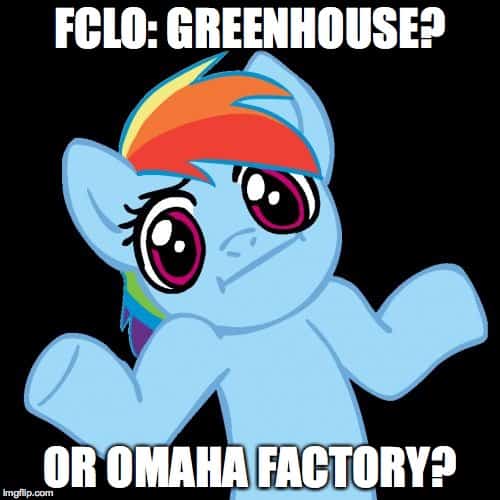
Added Vitamins?
They say they do not add vitamins.
Added Flavors?
Yes.

My Recommendation: Rosita EVCLO
Based on all of the above information, I can only recommend one brand of cod liver oil: Rosita EVCLO.
What If You Can’t Afford Rosita?
I believe that the health benefits make Rosita EVCLO well worth the price, especially for people who have health problems, and most especially for those of you who have children, especially children who have health problems…. including children on the spectrum.
If you don’t have money to spend on EVCLO, There are lots of ways to cut your food budget. I’m a big believer in saving money where I can (for example, dried beans cost half as much as canned beans; making your own bread is 50-70% cheaper than buying store-bought bread).
I use the money I save to buy quality supplements like Rosita EVCLO and raw milk, which is expensive but very worth it in my mind.
I wrote a post a while back about what to buy instead of cod liver oil if you are on a budget.
What I found, which I explain in the post, is that it’s very tough to replace the health benefits of EVCLO. You’d have to eat a lot of seafood to get the omega-3s, and eat liver or take liver supplements to get the vitamin A.
Is it possible to get these nutrients from other foods? Yes. Do I recommend it? No. Not unless you like eating sardines on a daily basis.
Yes, you can eat other types of seafood, but it will cost a lot more than if you just take EVCLO.
EVCLO is the most cost-effective way to make sure your family is getting the nutrition they need.
Don’t See a CLO Brand on This List?
If you see a brand that I left off this list and want me to add it, please comment below or you can email me at annmarie @ annmariemichaels dot com. I will be happy to check the brand out and add it to this list.
Questions? Please Comment Below
Please comment below with your questions about brands or anything you’d like to share.
UPDATES
Update October 27, 2016: I spent the past month looking into Dropi. Ultimately I cannot recommend their product. Read my post about Dropi here.
Update May 9, 2017: I’ve received 3 requests for reviews to be included… Standard Process, Swanson’s, and Nature’s Answer. I can’t recommend any of these products because they are all industrially processed.
Pin This Post
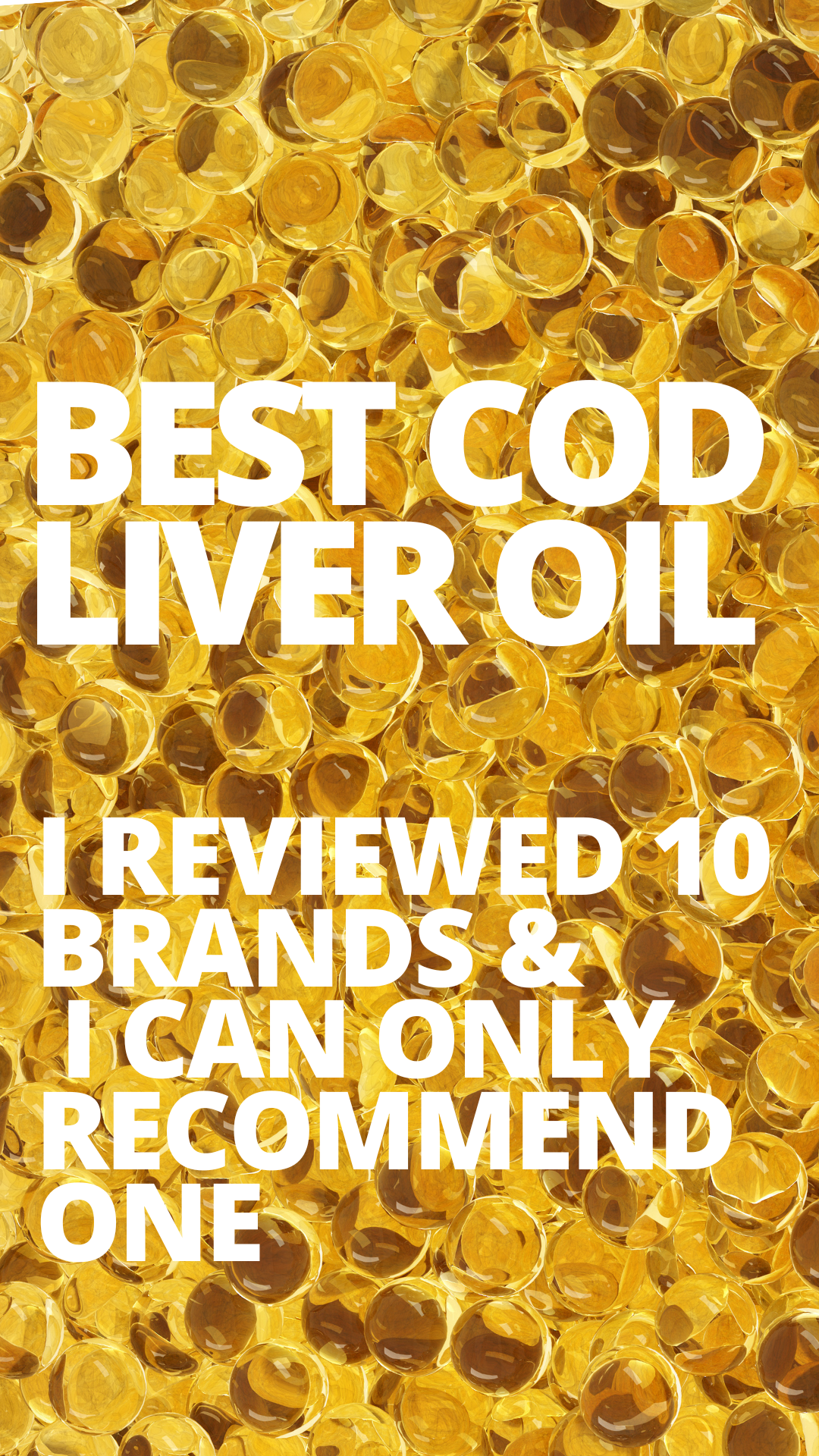



Comments ()